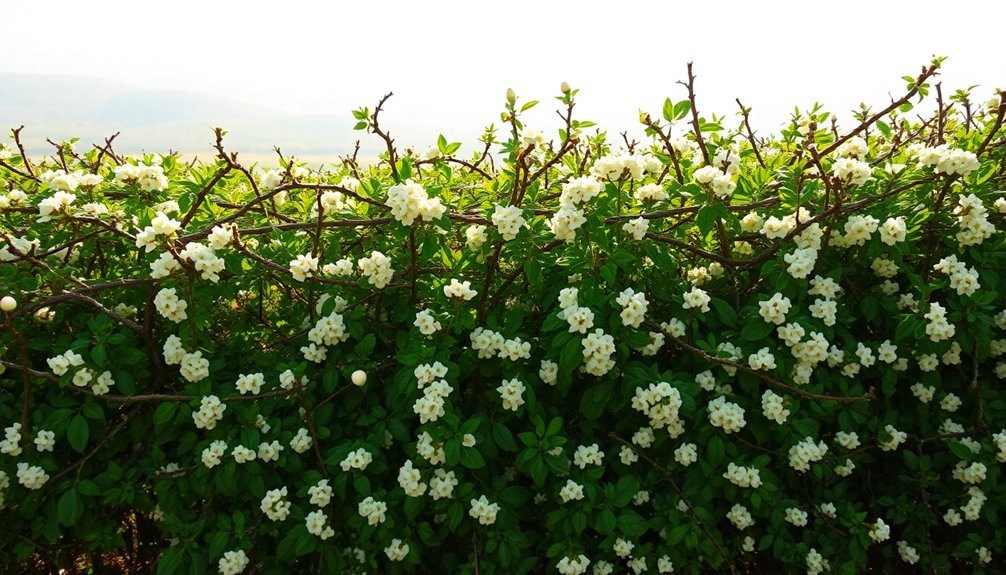The top three livestock hedges for natural fencing are hawthorn, Osage orange, and willow. Hawthorn creates a dense, thorny barrier that effectively contains animals while providing wildlife habitat. Osage orange forms an impenetrable living wall within four years, earning its nickname "nature's barbed wire." Willow thrives in wet conditions, growing up to 6 feet annually with minimal maintenance. These living fences offer ecological benefits traditional fencing can't match, while securing your livestock with time-tested natural solutions.
Hawthorn – The Classic Impenetrable Livestock Barrier

Four key features make hawthorn hedges the gold standard for natural livestock fencing. Their dense, thorny branches create an effective barrier that deters even the most determined livestock from breaking through. You'll find the thorns naturally discourage browsing and prevent overgrazing of your pastures.
When you plant hawthorns closely together, they'll develop into an impressive living wall over time. Though they grow relatively slowly, your patience will be rewarded with a hedge that not only contains animals but also stabilizes soil and prevents erosion. Traditional land managers used pleaching techniques to weave young hawthorn stems horizontally, creating an even more impenetrable barrier.
Beyond functionality, you're also creating valuable wildlife habitat. Your hawthorn hedge will provide nesting sites for birds, shelter for small mammals, and essential winter berries for various species, turning your property boundary into a biodiversity hotspot.
Osage Orange – Nature's Barbed Wire for Farm Boundaries
While hawthorn represents traditional European hedging, Osage orange stands as the American equivalent—a living fence that once dominated prairie landscapes.
You'll find this tree particularly valuable for its formidable thorns and dense growth pattern, creating an impenetrable barrier for livestock.
When planted closely, Osage orange forms a functional hedge within just four years. Its remarkable resistance to drought, insects, and disease guarantees your living fence will last for decades with proper maintenance.
Though regular pruning is necessary, you'll benefit from its soil-stabilizing root system and effective windbreak properties. Osage orange trees also provide valuable ecological services by supporting diverse edge habitats for wildlife.
Before barbed wire revolutionized fencing, farmers relied extensively on these hedges.
Today, you can still utilize this historical solution for environmentally friendly boundaries that simultaneously provide wildlife habitat while protecting your livestock and fields.
Willow and Black Locust – Quick-Growing Nutritional Hedgerows

If you're seeking rapid solutions for livestock boundaries, willow and black locust represent two outstanding options that establish themselves remarkably quickly.
Willow grows up to 6 feet annually and thrives in moist conditions, while black locust prefers dry, sunny areas.
Though both offer fast establishment, they serve different purposes. Willow supports early pollinators and requires minimal maintenance, forming dense hedges that deer typically avoid.
Black locust enriches surrounding soil through nitrogen fixation and provides fragrant white flowers, but its toxicity limits livestock browsing. Remember that black locust is toxic to livestock, including its seeds, bark, and leaves.
When planning your living fence, consider your specific conditions. Willow works well in wetter areas, offering shelter and potential browse.
For drier locations, black locust delivers durability and rot-resistance, though you'll need to manage its potential invasiveness.
Frequently Asked Questions
How Long Does It Take for a Livestock Hedge to Become Stock-Proof?
Your livestock hedge will typically take 5-10 years to become fully stock-proof. You'll need patience and regular maintenance during this establishment period to guarantee it develops into an effective natural barrier.
Can Livestock Hedges Be Planted Alongside Existing Wire Fencing?
Yes, you can plant livestock hedges alongside your existing wire fencing. This creates a hybrid system where the wire provides immediate containment while your hedge develops, eventually forming a beautiful, biodiversity-rich living barrier.
Which Hedges Are Best for Drought-Prone Areas?
For drought-prone areas, you'll find that Box, Oleaster, Lavender, Toyon, and Carissa 'Green Carpet' are excellent hedge choices. They're water-efficient with adaptations like small leaves or grey-green foliage that reflect sunlight.
How Do Livestock Hedges Impact Soil Quality Over Time?
Livestock hedges enrich your soil by increasing organic carbon by 22% compared to fields. You'll notice improved water infiltration, reduced erosion, and higher earthworm populations, creating healthier soil as roots develop over time.
Are There Edible Hedge Species That Benefit Both Humans and Livestock?
Yes, you'll find hazelnut hedges provide nuts for you and foliage for animals, while elderberry offers edible berries and barrier properties. Mulberries, sea buckthorn, and Russian olive similarly benefit both humans and livestock.
In Summary
You'll find these natural hedgerows transform your farm boundaries while providing ecological benefits conventional fencing can't match. Whether you choose hawthorn's impenetrable barrier, Osage orange's thorny defense, or the rapid growth of willow and black locust, you're investing in sustainable, long-term farm infrastructure. Start with small sections, maintain properly during establishment, and you'll create living fences that serve both your livestock and the environment.





Leave a Reply